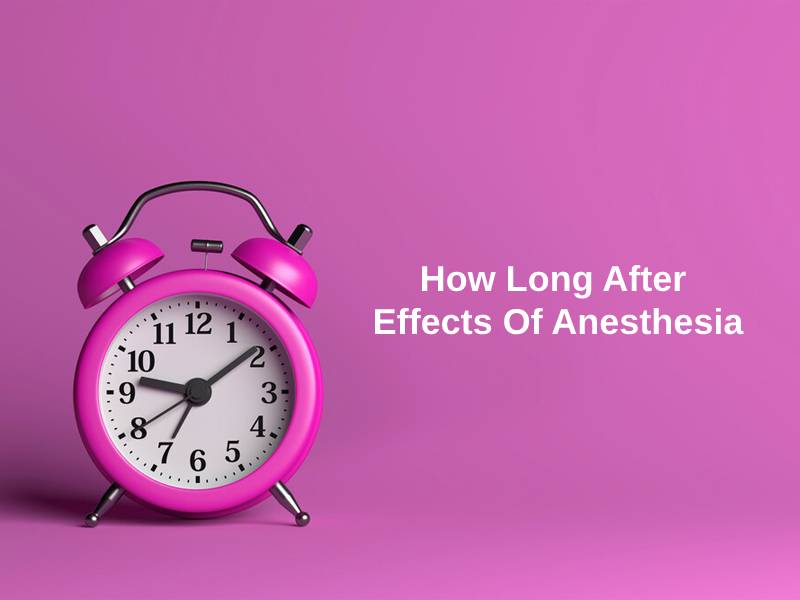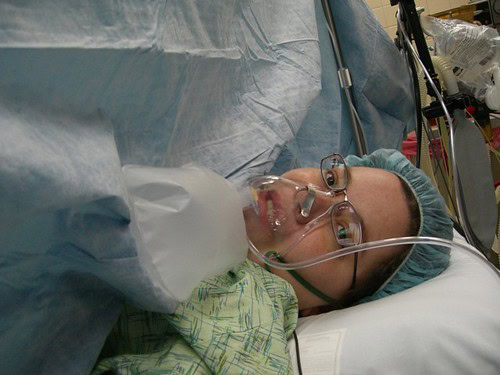Exact Answer: At least 45-60 minutes
Anesthesia is the name given to the usage of drugs known as anesthetics in order to prevent patients from feeling the sensation of pain while they undergo any medical procedure.
Different types of anesthesia have different functions and the degree to which they act. There are primarily four types of anesthesia: general anesthesia, local anesthesia, regional anesthesia, and monitored anesthesia care.
These types differ based on their level of pain-blocking, and method of administration. One may only numb a small part of the body but another may completely knock you out. The doctor decides which type of anesthesia to use based on the severity of the medical procedure, and your body condition and health.

How Long After Effects Of Anesthesia?
| Type of anesthesia | Time it takes for after effects to wear off |
| Local anesthesia | At least 4-6 hours |
| General anesthesia | 45-60 minutes after surgery ends |
| Regional anesthesia | 4-24 hours after surgery ends |
| Monitored anesthesia care | Up to 24 hours or more |
Local anesthesia is primarily used to numb only a small portion of the body temporarily. Medical procedures such as skin biopsies, dental procedures, and stitches can employ local anesthetics. Local anesthesia functions by halting the communication of pain signals from the affected part of the body to the brain. This is how local anesthesia helps numb the part which is affected.
Local anesthesia takes up to 4 to 6 hours for its after-effects to wear off, but it can take a longer or shorter time depending on the dosage administered and the severity of the procedure.
General anesthesia is used to keep a patient unconscious during the surgical procedure. Thus, they will not be able to feel any pain whatsoever during the procedure. General anesthetics are inhaled or given through an IV (intravenously). Patients are essentially in a coma that is medically induced, but it’s completely reversible.

Patients who were were administered general anesthetics wake up around 45-60 minutes after the surgery ends, in either the post-anesthesia care unit or the recovery room. But this time differs based on the type and dosage of the anesthetics used, and the surgery itself. After waking up, side effects such as nausea and vomiting might appear for a few days after the surgery.
Regional anesthesia is the administration of anesthetics as an injection that is injected near a bundle of nerves, in order to numb even the most remote sensations for a major part of the body, such as the entire lower body. This can be used for procedures such as leg or abdominal surgery, childbirth, and more.
One injection of regional anesthetics takes 4 to 24 hours after the surgery to wear off. But other side effects may persist for longer, but eventually, they will wear off as well.
Monitored anesthesia care (MAC) is used when the patient needs to be aware, but they must be completely calm and relaxed during the surgery. This kind of anesthesia allows the medical professional in charge to control the sedation level according to the type and severity of the surgery, and the patient’s health. The patient may be completely sedated and unaware, or only sedated moderately, or sedated lightly.
Depending on the level of MAC sedation that is administered, the patient may feel the after-effects for up to a day or more.
Why Do The After Effects Of Anesthesia Last That Long?
Local anesthetics come in two types: topical and injected anesthesia. Topical anesthetics are those that are directly applied to the mucus membranes like inside the nose, mouth, or throat, or skin surfaces. Topical anesthetics can be found as patches, creams, gels, liquids, and sprays. The second type is the injected local anesthesia. This is used in procedures such as dental surgeries, wart and mole removal, skin biopsies, and more.
General anesthesia is administered through an IV, or by inhaling the anesthetics. For general anesthesia, the patient may have to have a breathing tube inserted down their throat, as the muscles that enable the lungs to breathe will not function properly during the sedation period. The breathing tube will be connected to a ventilator that manually does the process of breathing for the patient.
Regional anesthesia is administered through a catheter that is injected near the bundle of nerves in order to cut off communication of pain from that part of the body that is supplied by the bundle of nerves.
For MAC anesthesia, the patient will receive the anesthetics through an intravenous catheter that is injected in the patient’s vein. This catheter will carry sedative medicine, pain medicine, and fluids.
It takes at least 24 hours for the anesthetics to be completely expelled from the body. This is why the after-effects of the anesthesia can be felt for that amount of time.
After-effects of general anesthesia include grogginess, disorientation, nausea, vomiting, dry mouth, chills, shivering, voice hoarseness, sore throat, dizziness, itching, bladder issues, muscle pain, bruising from IV, and more.

The usual after-effects of local anesthesia include numbness even after surgery ends, tingling, burning, twitching, dizziness, and more.
After-effects of regional anesthesia include weakness, numbness, heaviness, less control of affected muscle, and more.
After-effects that are commonly reported for MAC anesthesia are nausea, vomiting, drowsiness, difficulty with waking up from sedation, cardiorespiratory depression, and more.
Conclusion
In conclusion, the general rule of thumb regarding recovery time from the after-effects of anesthesia is 45-60 minutes after the procedure ends. But this varies depending on the type of anesthesia, your body’s health, and the dosage of anesthesia that is administered.
It takes at least 24 hours for the anesthetics to be removed from the body, so it will take a while before the patient feels normal again. There are common side effects such as nausea and vomiting that the patient may experience after the procedure ends, due to the anesthetics that were used.
You will be required to follow the doctor’s post-op instructions, in order to have a faster recovery rate, so you can feel better quicker.